The Trifid Nebula is a bright H II region located 4,100 light-years away in the southern constellation Sagittarius. With an apparent magnitude of 6.3 and an apparent size of 28 arcminutes, it can be easily observed in binoculars and small telescopes. The nebula is listed as Messier 20 (M20) in the Messier catalogue and NGC 6514 in the New General Catalogue.
The Trifid Nebula is one of the most striking Messier objects. It is a large star-forming region composed of three types of nebulae and a young open star cluster. The nebula has a diameter of 42 light years and lies in the Scutum-Centaurus Arm of the Milky Way.
The complex stellar nursery has a distinctive trifurcated appearance for which it is well known. The name Trifid means “divided into three lobes” and refers to the way the dark dust lanes appear to divide the nebula into three sections.
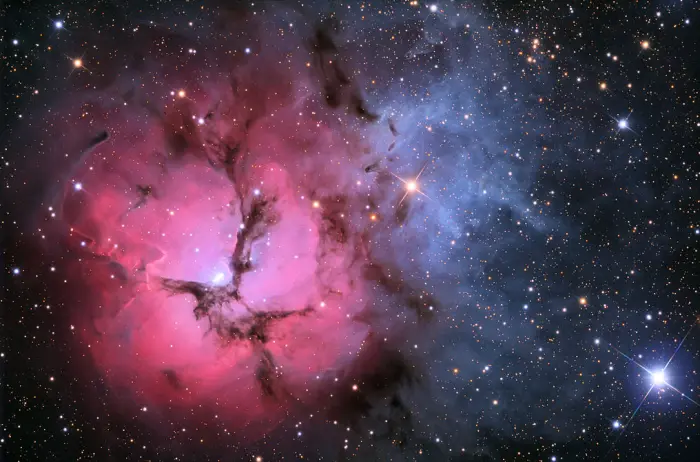
Trifid Nebula (Messier 20), image credit: Adam Block/Mount Lemmon SkyCenter/University of Arizona (CC BY-SA 4.0)
The Trifid Nebula consists of an emission nebula, a reflection nebula, and a dark nebula. The emission nebula, which appears reddish in long-exposure images, is composed of clouds of gas that is excited by the intense radiation of the massive stars in the vicinity. The high-energy photons emitted by these stars ionize the surrounding clouds in which they were born.
The red emission nebula in M20 is illuminated by the hot, massive, O-type stars that form the open cluster. Catalogued as C 1759-230, the star cluster in M20 is one of the youngest open clusters known.
The young stars in the cluster include a triple star system known as ADS 10991. The primary component in the system, ADS 10991 A (HD 164492A) is a hot, luminous blue star of the spectral type O7.5III. With a mass more than 20 times that of the Sun, it is the most massive star formed in the region. It is one of the 3,100 members of the young star cluster.
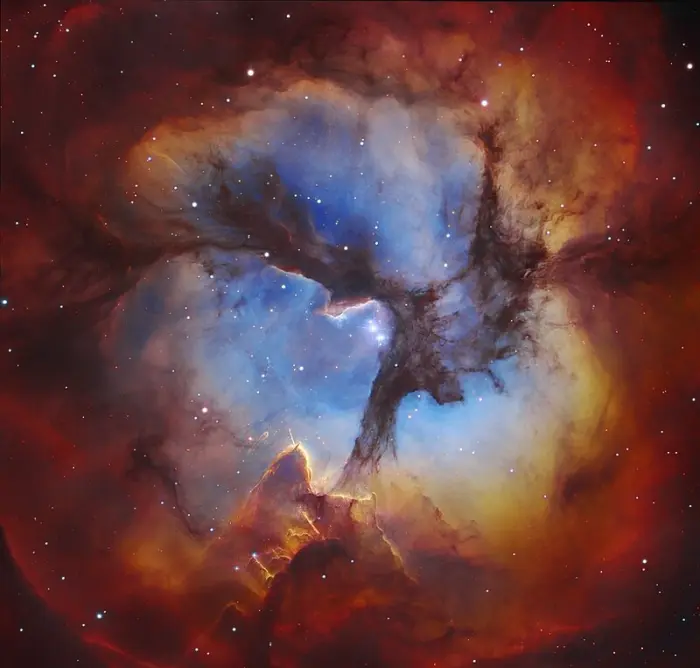
The centre of the Trifid Nebula, image credit: Subaru Telescope (NAOJ), Hubble Space Telescope, Martin Pugh; Processing: Robert Gendler (PD)
The intense radiation from the massive new stars has blown away the dust and gas in the region surrounding the cluster. As a result, there is no star forming activity occurring in the vicinity of the cluster anymore.
The blue reflection nebula reflects the light of the nearby stars, but the energy output of these stars is insufficient to make the gas clouds emit their own light and produce an emission nebula. The reflection nebula seen to the north is not physically associated with M20, but merely appears along the same line of sight.
The dark nebula consists of cold, dense clouds of interstellar dust. It absorbs the visible light of the emission and reflection nebula in the background. The dark nebula in M20 was catalogued by the American astronomer Edward Emerson Barnard as Barnard 85 (B85).
The bright open cluster that lies at the core of the emission nebula is partly obscured by the thick dust lanes which block visible light and conceal parts of the nebula’s central region. The dark dust lanes are silhouetted against the brighter nebula in the background.
Observations using NASA’s Spitzer Space Telescope in January 2005 resulted in the discovery of 30 massive embryonic stars and another 120 smaller newborn stars not previously seen in visible light images of the Trifid Nebula. Spitzer’s infrared eye was able to see through the obscuring dust and gas and identify young stars and protostars in the star forming region.
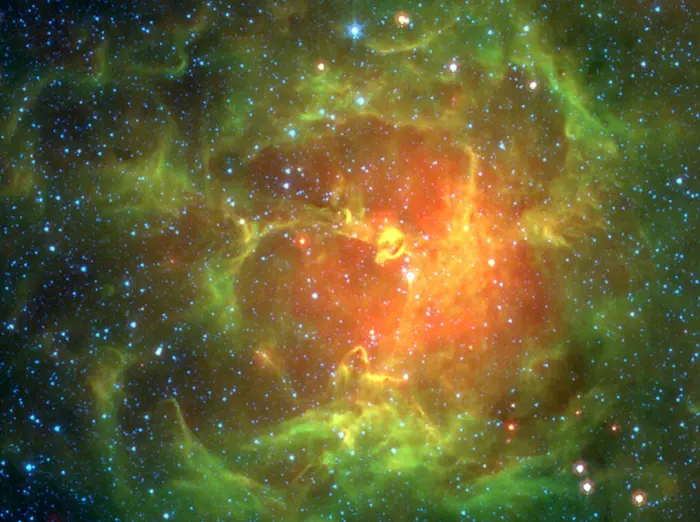
The Trifid Nebula, aka M20, is easy to find with a small telescope and a well-known stop in the nebula rich constellation Sagittarius. But where visible light pictures show the nebula divided into three parts by dark, obscuring dust lanes, this infrared image reveals filaments of luminous gas and newborn stars. This spectacular false-color view is courtesy of the Spitzer Space Telescope. Astronomers have used the Spitzer infrared image data to count newborn and embryonic stars that otherwise lie hidden in the natal dust and glowing clouds of this intriguing stellar nursery. Image credit: NASA, JPL-Caltech, J. Rho (SSC/Caltech) (PD)
The stars are scattered throughout the Trifid Nebula’s bright clouds and dark lanes of dust. The cloud containing the embryonic stars has a stellar jet about 0.75 light years in length emanating from a young star embedded within the stellar nursery.
Images of the Trifid Nebula reveal a stalk pointing from the thick cloud right of the jet. The stalk is dense enough not to be blown away by the star’s radiation. It is an example of an evaporating gaseous globule (EGG).
Evaporating gas globules are large, dense regions of hydrogen gas in which gases are shaded from the intense ionizing ultraviolet light of the nearby stars. These objects were first identified in the Pillars of Creation, a region of star formation within the larger Eagle Nebula (Messier 16) in the Serpens constellation, famously photographed by the Hubble Space Telescope in 1995.
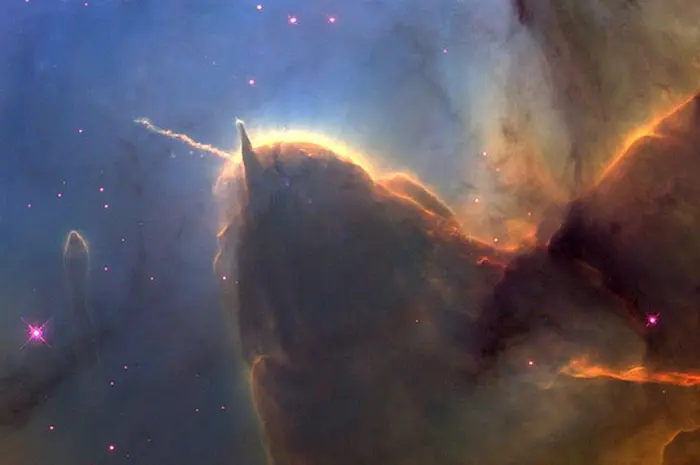
This NASA Hubble Space Telescope image of the Trifid Nebula reveals a stellar nursery being torn apart by radiation from a nearby, massive star. The picture also provides a peek at embryonic stars forming within an ill-fated cloud of dust and gas, which is destined to be eaten away by the glare from the massive neighbor. This stellar activity is a beautiful example of how the life cycles of stars like our Sun are intimately connected with their more powerful siblings. A stellar jet [the thin, wispy object pointing to the upper left] protrudes from the head of a dense cloud and extends three-quarters of a light-year into the nebula. The jet’s source is a very young stellar object that lies buried within the cloud. Jets such as this are the exhaust gases of star formation. Radiation from the massive star at the center of the nebula is making the gas in the jet glow, just as it causes the rest of the nebula to glow. The jet in the Trifid is a “ticker tape,” telling the history of one particular young stellar object that is continuing to grow as its gravity draws in gas from its surroundings. But this particular ticker tape will not run for much longer. Within the next 10,000 years the glare from the central, massive star will continue to erode the nebula, overrunning the forming star, and bringing its growth to an abrupt and possibly premature end. Another nearby star may have already faced this fate. The Hubble picture shows a “stalk” [the finger-like object] pointing from the head of the dense cloud directly toward the star that powers the Trifid. This stalk is a prominent example of the evaporating gaseous globules, or “EGGs,” that were seen previously in the Eagle Nebula, another star-forming region photographed by Hubble. The stalk has survived because at its tip there is a knot of gas that is dense enough to resist being eaten away by the powerful radiation. Image credit: NASA and Jeff Hester (Arizona State University) (PD)
Messier 20 is also a popular target for astrophotographers. It lies 2 degrees northwest of the brighter and larger Lagoon Nebula (Messier 8, mag. 4.6) and only 0.75 degrees northeast of Webb’s Cross (Messier 21), a magnitude 6.5 open cluster. The three bright objects appear in the same wide field in small telescopes.
The Trifid Nebula was once thought to lie at a much greater distance. However, more recent studies, based on the data obtained with the Gaia satellite, place M20 at a similar distance to the Lagoon Nebula.
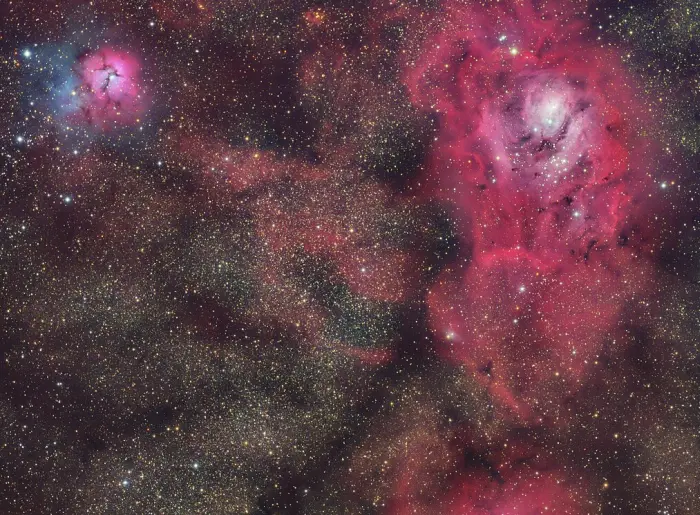
The Trifid Nebula (left) and the Lagoon Nebula (right), image credit: Ivan Bok (CC BY 4.0)
Facts
The Trifid Nebula was discovered by the French astronomer Charles Messier on June 5, 1764. Messier described the object as a “cluster of stars, a little above the Ecliptic, between the bow of Sagittarius and the right foot of Ophiuchus.” Messier discovered the open cluster M21 on the same day.
The German-born English astronomer William Herschel gave the nebula four different numbers when he included it in his catalogue in the 1780s: H IV.41, H V.10, H V.11, and H V.12.
John Herschel was the one to name the nebula Trifid after observing the dark dust lanes that divide it into three lobes.
The Danish astronomer John Louis Emil Dreyer, who compiled the New General Catalogue, described the Trifid Nebula as “a magnificent or otherwise interesting object, very bright, very large, trifid, double star involved.”
The Trifid Nebula is often mentioned in works of science fiction, including Beast Wars, a series set in the Transformers universe, and the Star Trek: The Original Series episode “The Alternative Factor,” in which M20 serves as a portal between two universes.
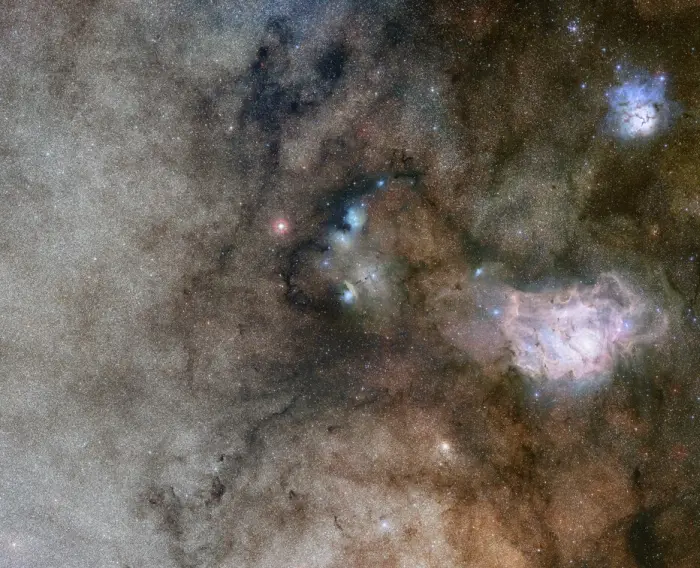
This very rich region of the Milky Way in the constellation of Sagittarius (The Archer) includes huge numbers of stars as well as several spectacular regions of star formation. At the centre lies Sharpless 29, which includes NGC 6559. To the right lies the very bright and famous Lagoon Nebula (Messier 8) and at the upper-right the Trifid Nebula (Messier 20) can be seen. This picture was created from images in the Digitized Sky Survey 2. Credit: ESO/Digitized Sky Survey 2; Acknowledgement: Davide De Martin (CC BY 4.0)
Location
The Trifid Nebula lies in the direction of the constellation Sagittarius. It appears in the north-western part of the constellation. It is easy to find because it lies near the Teapot asterism, a bright and conspicuous star pattern that makes the celestial Archer stand out in the sky.
Formed by the brightest stars of Sagittarius, the Teapot can be used to find many of the bright deep sky objects that appear in this region of the sky. The Trifid Nebula can be found by extending a line from Phi Sagittarii through Kaus Borealis (Lambda Sagittarii). Alternatively, it can be found by drawing a line from Kaus Australis, the brightest star in Sagittarius, through the midpoint of the imaginary line connecting Kaus Media and Alnasl.
The Trifid Nebula is one of the several bright deep sky objects that appear in this area of the sky. The brighter and larger Lagoon Nebula (Messier 8) appears just to the southeast and the open cluster Messier 21 (Webb’s Cross) lies to the northeast. The open cluster Messier 23, globular clusters Messier 22 and Messier 28, and several fainter star clusters appear in the same region.
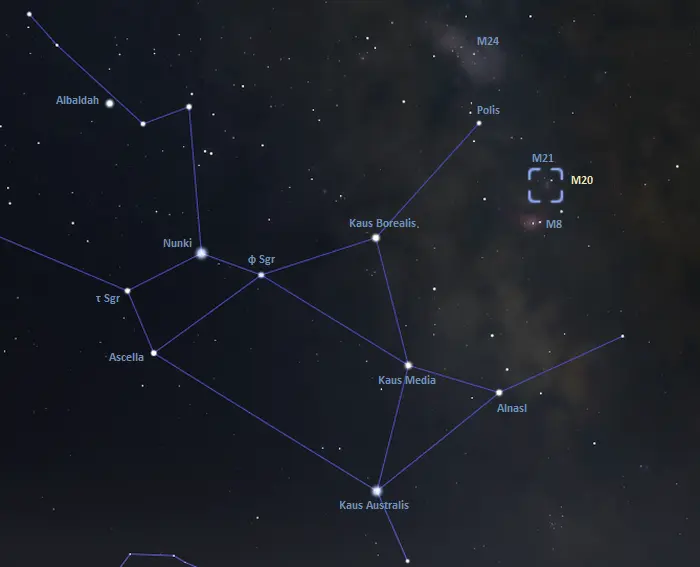
The location of the Trifid Nebula (Messier 20), image: Stellarium
In binoculars, the Trifid Nebula appears as a fuzzy circular patch. Small telescopes (80 mm or 3.1-inch) reveal the dark dust lanes. Larger telescopes (150 mm or 6-inch) show the Trifid Nebula’s irregular shape and the three dark lanes spreading from the nebula’s central region. The smaller compact cluster to the northeast of M20 is M21.
At declination -23°, the Trifid Nebula is visible from locations south of the latitude 66° N. It is best seen from the southern hemisphere because it does not rise very high above the horizon for observers in the northern hemisphere. The best time of the year to see Messier 20 and other deep sky objects in Sagittarius is during the month of August, when the constellation appears higher in the sky in the early evening.
Trifid Nebula – Messier 20
| Constellation | Sagittarius |
| Object type | H II region |
| Right ascension | 18h 02m 42s |
| Declination | −22° 58′ 18″ |
| Apparent magnitude | +6.3 |
| Apparent size | 28 arcminutes |
| Distance | 4,100 ± 200 light-years (1,260 ± 70 parsecs) |
| Radius | 21 light-years |
| Names and designations | Trifid Nebula, Messier 20, M20, NGC 6514, RCW 147, Sharpless 30, Gum 76, Collinder 360, CTB 45, LBN 006.99-00.17, LBN 27, LMH 12, NRL 10, MM 11, MSH 17-2-16, OCISM 2, OCl 23.0, MWSC 2789 |
Images
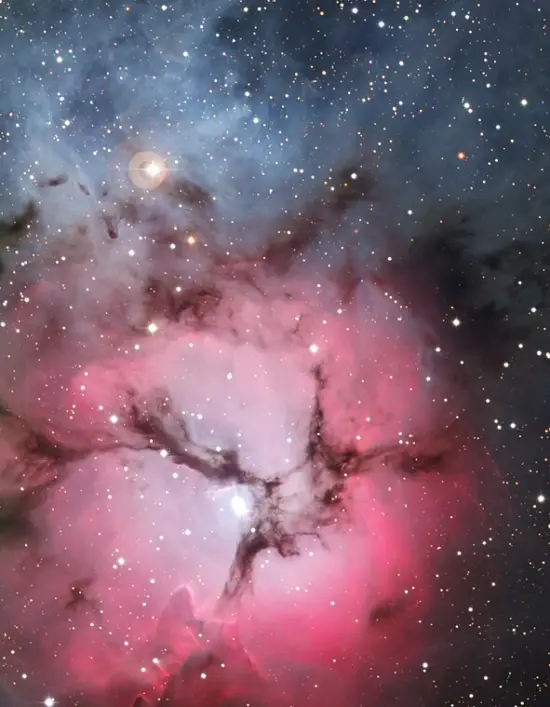
The massive star factory known as the Trifid Nebula was captured in all its glory with the Wide-Field Imager camera attached to the MPG/ESO 2.2-metre telescope at ESO’s La Silla Observatory in northern Chile. So named for the dark dust bands that trisect its glowing heart, the Trifid Nebula is a rare combination of three nebulae types that reveal the fury of freshly formed stars and point to more star birth in the future. The field of view of the image is approximately 13 x 17 arcminutes. Image credit: ESO (CC BY 3.0)
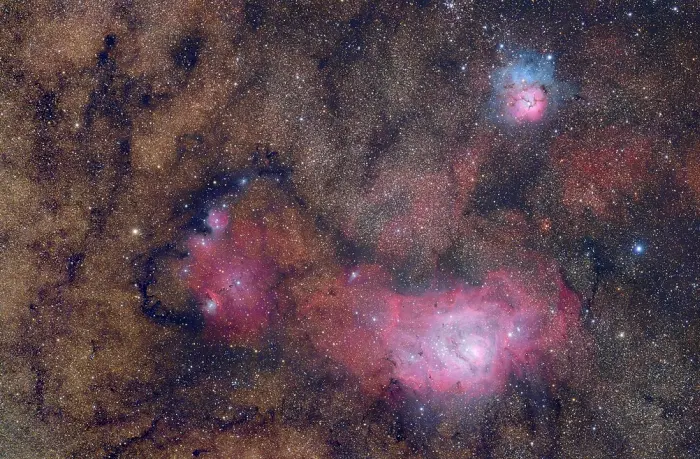
Lagoon and Trifid nebulae, image credit: Giuseppe Donatiello (CC0 1.0)
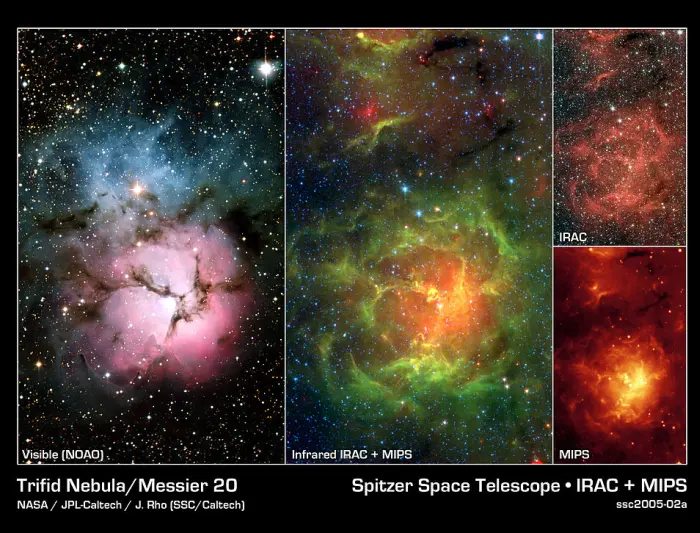
This image composite compares the well-known visible-light picture of the glowing Trifid Nebula (left panel) with infrared views from NASA’s Spitzer Space Telescope (remaining three panels). The false-color Spitzer images reveal a different side of the Trifid Nebula. Where dark lanes of dust are visible trisecting the nebula in the visible-light picture, bright regions of star-forming activity are seen in the Spitzer pictures. All together, Spitzer uncovered 30 massive embryonic stars and 120 smaller newborn stars throughout the Trifid Nebula, in both its dark lanes and luminous clouds. These stars are visible in all the Spitzer images, mainly as yellow or red spots. Credit: NASA/JPL-Caltech/J. Rho (SSC/Caltech) (PD)
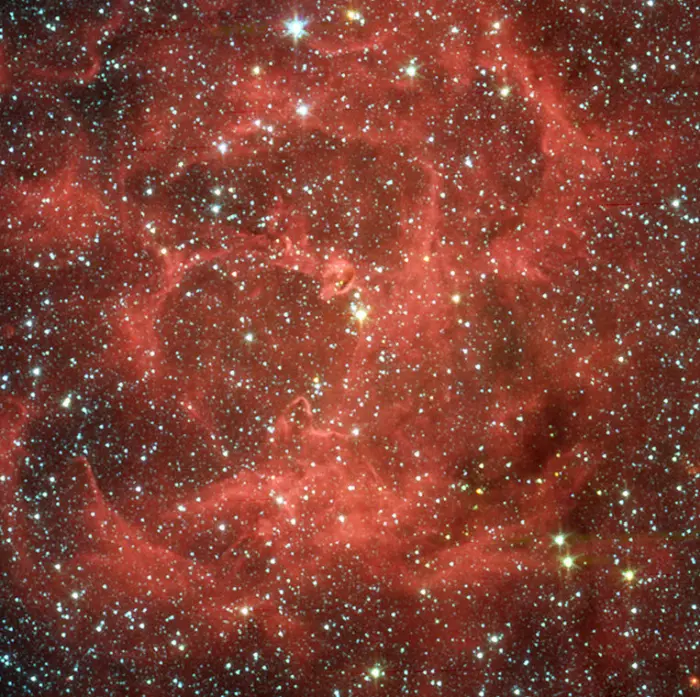
This image shows a close-up infrared view from NASA’s Spitzer Space Telescope of the glowing Trifid Nebula. Data of this same region from the Institute for Radioastronomy millimeter telescope in Spain revealed four dense knots, or cores, of dust, which are “incubators” for embryonic stars. Astronomers thought these cores were not yet ripe for stars, until Spitzer spotted the warmth of rapidly growing massive embryos tucked inside.These embryos are revealed in the false-color Spitzer picture, taken by the telescope’s infrared array camera (IRAC). Spitzer found clusters of embryos in two of the cores and only single embryos in the other two. This is one of the first times that multiple embryos have been observed in individual cores at this early stage of stellar development. Image credit: NASA/JPL-Caltech/J. Rho (SSC/Caltech), 2005 (PD)
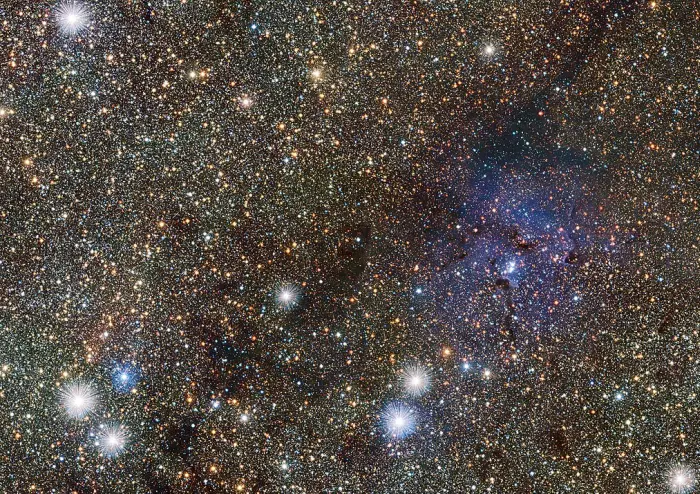
This small extract from the VISTA VVV survey of the central parts of the Milky Way shows the famous Trifid Nebula to the right of centre. It appears as faint and ghostly at these infrared wavelengths when compared to the familiar view at visible wavelengths. This transparency has brought its own benefits — many previously hidden background objects can now be seen clearly. Among these are two newly discovered Cepheid variable stars, the first ever spotted on the far side of the galaxy near its central plane. Credit: ESO/VVV consortium/D. Minniti (CC BY 4.0)
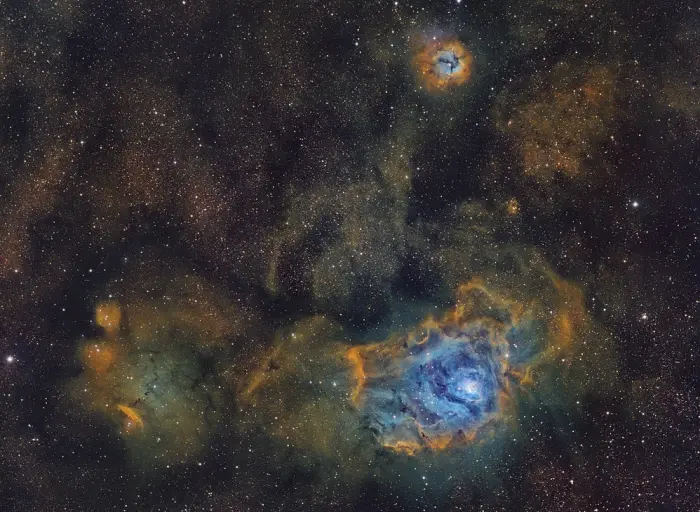
In this image of the Lagoon and Trifid Nebulae, the object is represented in a different light as opposed to the earlier true colour image. Instead of the usual RGB method of obtaining true colours of deep sky objects, the image featured here is an emission-line filtered image which represents the nebula’s chemical composition. In this case, the nebula is photographed using a modified version of what is known as the Hubble palette, in which three filters to isolate Sulfur, Hydrogen and Oxygen emissions are used. The data from these three filters are then mapped to Red, Green and Blue respectively to create a false colour composite as depicted above. Due to the overwhelming presence of hydrogen in the Universe, most of the objects photographed using this palette will therefore appear predominantly green, a contrast from the usual strongly red colours that ionized hydrogen emits when photographed in natural colour. Image credit: Ivan Bok (CC BY 4.0)
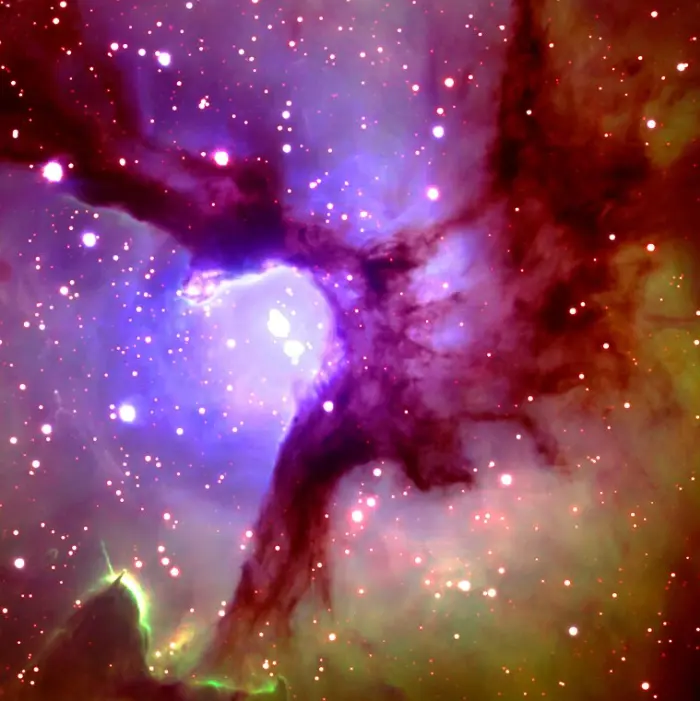
Image of the central region of the Trifid Nebula (M20 in the Messier Catalogue) taken by the Gemini North 8-meter Telescope on Mauna Kea on the Big Island of Hawaii, June 5, 2002. Located in the constellation of Sagittarius, the beautiful nebula is a much-photographed, dynamic cloud of gas and dust where stars are being born. One of the massive stars at the nebula’s center was born approximately 100,000 years ago. Credit: Gemini Observatory / GMOS Image (CC BY 4.0)
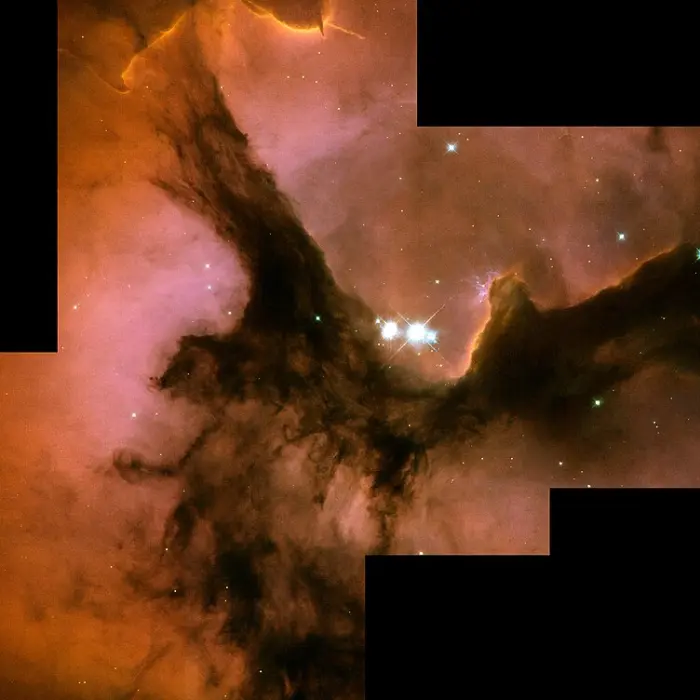
Three huge intersecting dark lanes of interstellar dust make the Trifid Nebula one of the most recognizable and striking star birth regions in the night sky. The dust, silhouetted against glowing gas and illuminated by starlight, cradles the bright stars at the heart of the Trifid. This image from NASA’s Hubble Space Telescope, offers a close-up view of the center of the Trifid Nebula, near the intersection of the dust bands, where a group of recently formed, massive, bright stars is easily visible. Image credit: NASA, ESA, and The Hubble Heritage Team (AURA/STScI) (PD)
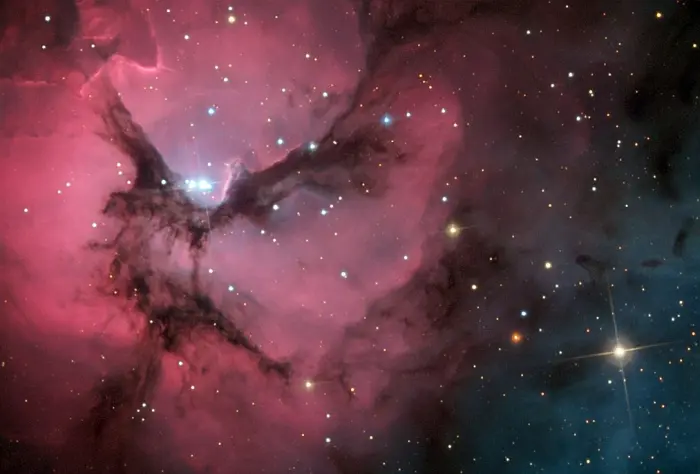
This image of the Trifid Nebula was taken as part of Advanced Observing Program (AOP) program at Kitt Peak Visitor Center during 2014. Credit: KPNO/NOIRLab/NSF/AURA/Jim and Janet Castano/Adam Block (CC BY 4.0)
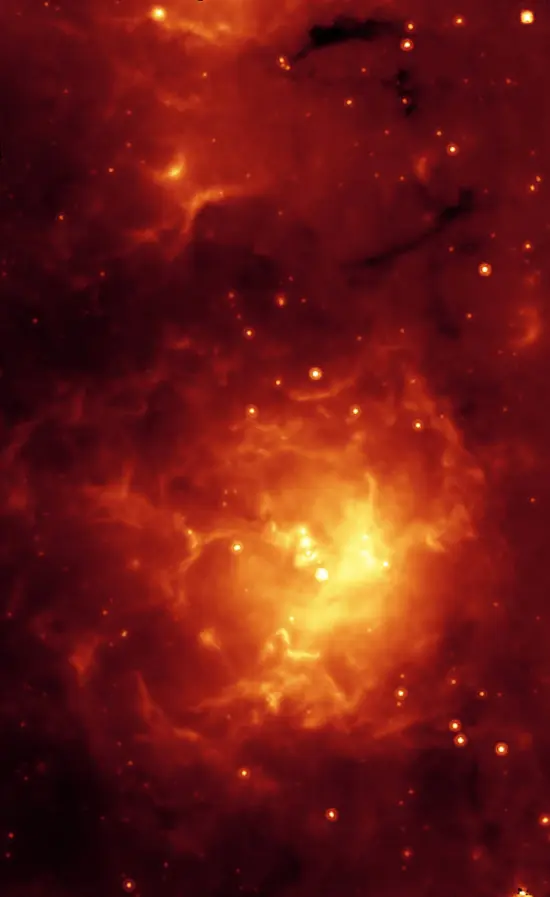
The pseudo-color Spitzer image reveals a different side of the Trifid Nebula. Where dark lanes of dust are visible trisecting the nebula in a visible-light picture, bright regions of star-forming activity are seen in the Spitzer picture. All together, Spitzer uncovered 30 massive embryonic stars and 120 smaller newborn stars throughout the Trifid Nebula, in both its dark lanes and luminous clouds. Credit: NASA/JPL-Caltech/J. Rho (SSC/Caltech) (PD)